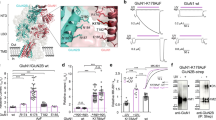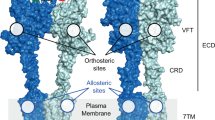Abstract
Allosteric modulators of ion channels typically alter the transitions rates between conformational states without changing the properties of the open pore. Here we describe a new class of positive allosteric modulators of N-methyl d-aspartate receptors (NMDARs) that mediate a calcium-permeable component of glutamatergic synaptic transmission and play essential roles in learning, memory and cognition, as well as neurological disease. EU1622-14 increases agonist potency and channel-open probability, slows receptor deactivation and decreases both single-channel conductance and calcium permeability. The unique functional selectivity of this chemical probe reveals a mechanism for enhancing NMDAR function while limiting excess calcium influx, and shows that allosteric modulators can act as biased modulators of ion-channel permeation.
This is a preview of subscription content, access via your institution
Access options
Access Nature and 54 other Nature Portfolio journals
Get Nature+, our best-value online-access subscription
$29.99 / 30 days
cancel any time
Subscribe to this journal
Receive 12 print issues and online access
$259.00 per year
only $21.58 per issue
Buy this article
- Purchase on Springer Link
- Instant access to full article PDF
Prices may be subject to local taxes which are calculated during checkout






Similar content being viewed by others
Data availability
The data that support the findings of this study are available from the corresponding author upon reasonable request.
Code availability
The code that support the analysis of the findings contained in this study are available from the corresponding author upon reasonable request.
References
Traynelis, S. F. et al. Glutamate receptor ion channels: structure, regulation, and function. Pharm. Rev. 62, 405–496 (2010).
Coyle, J. T., Tsai, G. & Goff, D. Converging evidence of NMDA receptor hypofunction in the pathophysiology of schizophrenia. Ann. N. Y. Acad. Sci. 1003, 318–327 (2003).
Heresco-Levy, U., Javitt, D. C., Ermilov, M., Silipo, G. & Shimoni, J. Double-blind, placebo-controlled, crossover trial of d-cycloserine adjuvant therapy for treatment-resistant schizophrenia. Int. J. Neuropsychopharmacol. 1, 131–135 (1998).
Hu, C., Chen, W., Myers, S. J., Yuan, H. & Traynelis, S. F. Human GRIN2B variants in neurodevelopmental disorders. J. Pharm. Sci. 132, 115–121 (2016).
Ingram, D. K. et al. New pharmacological strategies for cognitive enhancement using a rat model of age-related memory impairment. Ann. N. Y. Acad. Sci. 717, 16–32 (1994).
Javitt, D. C. Management of negative symptoms of schizophrenia. Curr. Psychiatry Rep. 3, 413–417 (2001).
Yuan, H., Low, C. M., Moody, O. A., Jenkins, A. & Traynelis, S. F. Ionotropic GABA and glutamate receptor mutations and human neurologic diseases. Mol. Pharmacol. 88, 203–217 (2015).
Choi, D. W. Excitotoxic cell death. J. Neurobiol. 23, 1261–1276 (1992).
Parsons, M. P. & Raymond, L. A. Extrasynaptic NMDA receptor involvement in central nervous system disorders. Neuron 82, 279–293 (2014).
Gonzalez, J. et al. NMDARs in neurological diseases: a potential therapeutic target. Int J. Neurosci. 125, 315–327 (2015).
Collingridge, G. L. et al. The NMDA receptor as a target for cognitive enhancement. Neuropharmacology 64, 13–26 (2013).
Schade, S. & Paulus, W. d-Cycloserine in neuropsychiatric diseases: a systematic review. Int. J. Neuropsychopharmacol. 19, pyv102 (2016).
Chopra, D. A. et al. A single-channel mechanism for pharmacological potentiation of GluN1/GluN2A NMDA receptors. Sci. Rep. 7, 6933 (2017).
Hackos, D. H. et al. Positive allosteric modulators of GluN2A-containing NMDARs with distinct modes of action and impacts on circuit function. Neuron 89, 983–999 (2016).
Khatri, A. et al. Structural determinants and mechanism of action of a GluN2C-selective NMDA receptor positive allosteric modulator. Mol. Pharmacol. 86, 548–560 (2014).
Perszyk, R. E. et al. GluN2D-Containing N-methyl-d-aspartate receptors mediate synaptic transmission in hippocampal interneurons and regulate interneuron activity. Mol. Pharmacol. 90, 689–702 (2016).
Sapkota, K. et al. Mechanism and properties of positive allosteric modulation of N-methyl-d-aspartate receptors by 6-alkyl 2-naphthoic acid derivatives. Neuropharmacology 125, 64–79 (2017).
Strong, K. L. et al. The structure–activity relationship of a tetrahydroisoquinoline class of N-methyl-d-aspartate receptor modulators that potentiates GluN2B-containing N-methyl-d-aspartate receptors. J. Med. Chem. 60, 5556–5585 (2017).
Wang, T. M. et al. A novel NMDA receptor positive allosteric modulator that acts via the transmembrane domain. Neuropharmacology 121, 204–218 (2017).
Mullasseril, P. et al. A subunit-selective potentiator of NR2C- and NR2D-containing NMDA receptors. Nat. Commun. 1, 90 (2010).
Hansen, K. B. et al. Implementation of a fluorescence-based screening assay identifies histamine H3 receptor antagonists clobenpropit and iodophenpropit as subunit-selective N-methyl-d-aspartate receptor antagonists. J. Pharmacol. Exp. Ther. 333, 650–662 (2010).
Ogden, K. K. et al. Molecular mechanism of disease-associated mutations in the pre-M1 helix of NMDA receptors and potential rescue pharmacology. PLoS Genet. 13, e1006536 (2017).
Karakas, E. & Furukawa, H. Crystal structure of a heterotetrameric NMDA receptor ion channel. Science 344, 992–997 (2014).
Lee, C. H. et al. NMDA receptor structures reveal subunit arrangement and pore architecture. Nature 511, 191–197 (2014).
Gibb, A. J. et al. A structurally derived model of subunit-dependent NMDA receptor function. J. Physiol. 596, 4057–4089 (2018).
Ogden, K. K. & Traynelis, S. F. Contribution of the M1 transmembrane helix and pre-M1 region to positive allosteric modulation and gating of N-methyl-d-aspartate receptors. Mol. Pharmacol. 83, 1045–1056 (2013).
Sobolevsky, A. I., Prodromou, M. L., Yelshansky, M. V. & Wollmuth, L. P. Subunit-specific contribution of pore-forming domains to NMDA receptor channel structure and gating. J. Gen. Physiol. 129, 509–525 (2007).
Kazi, R. et al. Asynchronous movements prior to pore opening in NMDA receptors. J. Neurosci. 33, 12052–12066 (2013).
Talukder, I., Borker, P. & Wollmuth, L. P. Specific sites within the ligand-binding domain and ion channel linkers modulate NMDA receptor gating. J. Neurosci. 30, 11792–11804 (2010).
Perszyk, R et al. An NMDAR positive and negative allosteric modulator series share a binding site and are interconverted by methyl groups. Elife 7, e34711 (2018).
Swanger, S. A. et al. A novel negative allosteric modulator selective for GluN2C/2D-containing NMDA receptors inhibits synaptic transmission in hippocampal interneurons. ACS Chem. Neurosci. 9, 306–319 (2018).
Zhu, S. et al. Mechanism of NMDA receptor inhibition and activation. Cell 165, 704–714 (2016).
Twomey, E. C. & Sobolevsky, A. I. Structural mechanisms of gating in ionotropic glutamate receptors. Biochemistry 57, 267–276 (2018).
Watanabe, J., Beck, C., Kuner, T., Premkumar, L. S. & Wollmuth, L. P. DRPEER: a motif in the extracellular vestibule conferring high Ca2+ flux rates in NMDA receptor channels. J. Neurosci. 22, 10209–10216 (2002).
Schewe, M. et al. A pharmacological master key mechanism that unlocks the selectivity filter gate in K+ channels. J. Sci. 363, 875–880 (2019).
Traynelis, S. F. & Jaramillo, F. Getting the most out of noise in the central nervous system. Trends Neurosci. 21, 137–145 (1998).
Lester, R. A., Clements, J. D., Westbrook, G. L. & Jahr, C. E. Channel kinetics determine the time course of NMDA receptor-mediated synaptic currents. Nature 346, 565–567 (1990).
Mizuta, I., Katayama, M., Watanabe, M., Mishina, M. & Ishii, K. Developmental expression of NMDA receptor subunits and the emergence of glutamate neurotoxicity in primary cultures of murine cerebral cortical neurons. Cell. Mol. Life Sci. 54, 721–725 (1998).
Erreger, K. et al. Subunit-specific agonist activity at NR2A-, NR2B-, NR2C-, and NR2D-containing N-methyl-d-aspartate glutamate receptors. Mol. Pharmacol. 72, 907–920 (2007).
Dravid, S. M., Prakash, A. & Traynelis, S. F. Activation of recombinant NR1/NR2C NMDA receptors. J. Physiol. 586, 4425–4439 (2008).
Wyllie, D. J., Behe, P., Nassar, M., Schoepfer, R. & Colquhoun, D. Single-channel currents from recombinant NMDA NR1a/NR2D receptors expressed in Xenopus oocytes. Proc. Biol. Sci. 263, 1079–1086 (1996).
Premkumar, L. S. & Auerbach, A. Identification of a high affinity divalent cation binding site near the entrance of the NMDA receptor channel. Neuron 16, 869–880 (1996).
Lewis, C. A. Ion-concentration dependence of the reversal potential and the single channel conductance of ion channels at the frog neuromuscular junction. J. Physiol. 286, 417–445 (1979).
Jatzke, C., Watanabe, J. & Wollmuth, L. P. Voltage and concentration dependence of Ca2+ permeability in recombinant glutamate receptor subtypes. J. Physiol. 538, 25–39 (2002).
Siegler Retchless, B., Gao, W. & Johnson, J. W. A single GluN2 subunit residue controls NMDA receptor channel properties via intersubunit interaction. Nat. Neurosci. 15, 406–413 (2012).
Wollmuth, L. P. & Sakmann, B. Different mechanisms of Ca2+ transport in NMDA and Ca2+-permeable AMPA glutamate receptor channels. J. Gen. Physiol. 112, 623–636 (1998).
Woodhull, A. M. Ionic blockage of sodium channels in nerve. J. Gen. Physiol. 61, 687–708 (1973).
Rosenmund, C., Stern-Bach, Y. & Stevens, C. F. The tetrameric structure of a glutamate receptor channel. Science 280, 1596–1599 (1998).
Zheng, J. & Sigworth, F. J. Selectivity changes during activation of mutant shaker potassium channels. J. Gen. Physiol. 110, 101–117 (1997).
Ikonomidou, C. & Turski, L. Why did NMDA receptor antagonists fail clinical trials for stroke and traumatic brain injury? Lancet Neurol. 1, 383–386 (2002).
Colquhoun, D. & Sigworth, F. J. In Single-Channel Recording (Eds Sakmann, B. & Neher, E.) 483–587 (Springer, 1995).
Neher, E. Correction for liquid junction potentials in patch clamp experiments. Methods Enzymol. 207, 123–131 (1992).
Burnashev, N., Zhou, Z., Neher, E. & Sakmann, B. Fractional calcium currents through recombinant GluR channels of the NMDA, AMPA and kainate receptor subtypes. J. Physiol. 485, 403–418 (1995).
Paoletti, P., Neyton, J. & Ascher, P. Glycine-independent and subunit-specific potentiation of NMDA responses by extracellular Mg2+. Neuron 15, 1109–1120 (1995).
Traynelis, S. F. Software-based correction of single compartment series resistance errors. J. Neurosci. Methods 86, 25–34 (1998).
Acknowledgements
The authors thank K. Ogden for help with analytical software development and Y. Du and the Emory Chemical Biology Discovery Center for their invaluable assistance. This work was supported by the NINDS (NS065371 and NS111619, to S.F.T.), NICHD (HD082373, to H.Y.), NIMH (MH109026, to G.B.), Citizens United for Research in Epilepsy (to S.A.S.) and the Emory University Research Committee (to S.A.S.).
Author information
Authors and Affiliations
Contributions
The authors contributed in the following manner: conceptualization (S.F.T., R.E.P. and S.A.S.); data curation and formal analysis (R.E.P., S.A.S., C.S., A.K., G.F.-C., H.Y. and S.F.T.); funding acquisition (S.A.S., S.F.T., H.Y., D.C.L. and G.J.B.); investigation (R.E.P., S.A.S., C.S., A.K., J.Z., P.L., E.G.-A., G.F.-C., M.P.E., D.S.M. and P.B.); development or design of methodology (R.E.P., S.A.S., S.F.T., E.G.-A., G.F.-C., M.P.E., G.J.B., D.S.M., D.C.L. and L.S.L.); project administration (R.E.P., S.F.T. and S.A.S.); provision of reagents, materials and analysis tools (P.K.R.G., E.G.-A., G.F.-C., P.B., G.J.B., M.P.E., D.S.M., D.C.L. and L.S.L.); software (R.E.P. and S.F.T.); supervision (S.F.T., L.S.L., D.C.L. and G.J.B.); verification (R.E.P., S.A.S., C.S., A.K., G.F.-C., M.P.E. and D.S.M.); and visualization and writing (all authors).
Corresponding author
Ethics declarations
Competing interests
Several authors have competing interests. S.F.T. is a consultant for Janssen Pharmaceuticals, principal investigator on research grants from Janssen and Allergan to Emory University School of Medicine, a member of the scientific advisory board for Sage Therapeutics, the GRIN2B Foundation, and the CureGRIN Foundation, co-founder of NeurOp and receives royalties for software. D.C.L. is a member of the Board of Directors for NeurOp. D.C.L., D.S.M., E.G.A., G.F.C., P.K.R.G., L.S.L., M.P.E., S.F.T. are co-inventors on Emory-owned intellectual property that includes allosteric modulators of NMDA receptor function. H.Y. is principal investigator on a research grant from Sage Therapeutics to Emory University School of Medicine.
Additional information
Publisher’s note Springer Nature remains neutral with regard to jurisdictional claims in published maps and institutional affiliations.
Supplementary information
Supplementary Information
Supplementary Figs. 1–11, Supplementary Tables 1–12 and Synthetic Procedures.
Rights and permissions
About this article
Cite this article
Perszyk, R.E., Swanger, S.A., Shelley, C. et al. Biased modulators of NMDA receptors control channel opening and ion selectivity. Nat Chem Biol 16, 188–196 (2020). https://doi.org/10.1038/s41589-019-0449-5
Received:
Revised:
Accepted:
Published:
Issue Date:
DOI: https://doi.org/10.1038/s41589-019-0449-5
This article is cited by
-
Therapeutic potential of N-methyl-D-aspartate receptor modulators in psychiatry
Neuropsychopharmacology (2024)
-
Isomerization of bioactive acylhydrazones triggered by light or thiols
Nature Chemistry (2023)
-
Two gates mediate NMDA receptor activity and are under subunit-specific regulation
Nature Communications (2023)
-
Novel neuroactive steroids as positive allosteric modulators of NMDA receptors: mechanism, site of action, and rescue pharmacology on GRIN variants associated with neurological conditions
Cellular and Molecular Life Sciences (2023)
-
Complex functional phenotypes of NMDA receptor disease variants
Molecular Psychiatry (2022)



